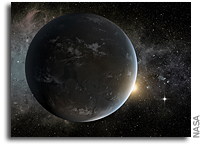Geothermal Heating Enhances Atmospheric Asymmetries on Synchronously Rotating Planets

Earth-like planets within the liquid water habitable zone of M type stars may evolve into synchronous rotators.
On these planets, the sub-stellar hemisphere experiences perpetual daylight while the opposing anti-stellar hemisphere experiences perpetual darkness. Because the night-side hemisphere has no direct source of energy, the air over this side of the planet is prone to freeze out and deposit on the surface, which could result in atmospheric collapse. However, general circulation models (GCMs) have shown that atmospheric dynamics can counteract this problem and provide sufficient energy transport to the anti-stellar side.
Here we use an idealized GCM to consider the impact of geothermal heating on the habitability of synchronously rotating planets. Geothermal heating may be expected due to tidal interactions with the host star, and the effects of geothermal heating provide additional habitable surface area and may help to induce melting of ice on the anti-stellar hemisphere. We also explore the persistence of atmospheric asymmetries between the northern and southern hemispheres, and we find that the direction of the meridional circulation (for rapidly rotating planets) or the direction of zonal wind (for slowly rotating planets) reverses on either side of the sub-stellar point.
We show that the zonal circulation approaches a theoretical state similar to a Walker circulation only for slowly rotating planets, while rapidly rotating planets show a zonal circulation with the opposite direction. We find that a cross-polar circulation is present in all cases and provides an additional mechanism of mass and energy transport from the sub-stellar to anti-stellar point. Characterization of the atmospheres of synchronously rotating planets should include consideration of hemispheric differences in meridional circulation and examination of transport due to cross-polar flow.
Jacob Haqq-Misra, Ravi Kumar Kopparapu (Submitted on 30 Sep 2014)
Comments: Accepted for publication in MNRAS
Subjects: Earth and Planetary Astrophysics (astro-ph.EP); Atmospheric and Oceanic Physics (physics.ao-ph)
Cite as: arXiv:1410.0186 [astro-ph.EP] (or arXiv:1410.0186v1 [astro-ph.EP] for this version)
Submission history From: Jacob Haqq-Misra [v1] Tue, 30 Sep 2014 15:38:49 GMT (12908kb,D) http://arxiv.org/abs/1410.0186








